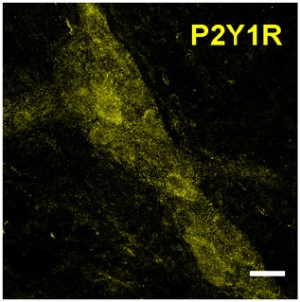Overview
Cat #:
APR-009
Alternative Name P2Y purinoceptor 1, P2RY1
Lyophilized Powder yes
Type: Polyclonal
Host: Rabbit
Reactivity: H, M, R
Immunogen
Accession (Uniprot) Number P49651
Gene ID 25265
Peptide confirmation Confirmed by amino acid analysis and mass spectrometry.
Homology Rat, human, bovine - identical; turkey, chicken - 16/17 amino acid residues identical; mouse - 15/17 amino acid residues identical.
RRID AB_2040070.
Purity Affinity purified on immobilized antigen.
Form Lyophilized powder. Reconstituted antibody contains phosphate buffered saline (PBS), pH 7.4, 1% BSA, 0.05% NaN3.
Form Lyophilized powder. Reconstituted antibody contains phosphate buffered saline (PBS), pH 7.4.
Isotype Rabbit IgG.
Storage before reconstitution The antibody ships as a lyophilized powder at room temperature. Upon arrival, it should be stored at -20°C.
Reconstitution 25 µl, 50 µl or 0.2 ml double distilled water (DDW), depending on the sample size.
Reconstitution 0.2 ml double distilled water (DDW).
Antibody concentration after reconstitution 0.8 mg/ml.
Storage after reconstitution The reconstituted solution can be stored at 4°C for up to 1 week. For longer periods, small aliquots should be stored at -20°C. Avoid multiple freezing and thawing. Centrifuge all antibody preparations before use (10000 x g 5 min).
Standard quality control of each lot Western blot analysis.
Applications: ICC, IF, IFC, IHC, IP, WB
Cited Applications: ICC*, IFC*, IHC*
Western blot
 Western blot analysis of rat brain membranes (lanes 1 and 3) and human platelets lysate (lanes 2 and 4):1,2. Anti-P2Y1 Receptor Antibody (#APR-009), (1:200).
Western blot analysis of rat brain membranes (lanes 1 and 3) and human platelets lysate (lanes 2 and 4):1,2. Anti-P2Y1 Receptor Antibody (#APR-009), (1:200).
3,4. Anti-P2Y1 Receptor Antibody, preincubated with P2Y1 Receptor Blocking Peptide (#BLP-PR009).- Rat brain membranes, human platelets (1:200-1:400). Mouse spinal cord astrocyte lysate (1:200) (Suadicani, S.O. et al. (2003) Glia 42, 160.).
Immunoprecipitation
- Rat cortical neuron lysate (4 μg) (Siow, N.L. et al. (2010) Mol. Pharmacol. 78, 1059.).
Immunohistochemistry
- Rat brain sections. Human eye tissue (Fries, J.E. et al. (2005) Invest. Ophthalmol. Vis. Sci. 46, 3000.).
Immunocytochemistry
- Rat primary hippocampal neurons (1:100) (Filippov, A.K. et al. (2006) J. Neurosci. 26, 9340.).
Indirect flow cytometry
- Rat osteoclasts (6 μg/ml) (Alvarenga, E.C. et al. (2010) Bone 46, 355.).
- The blocking peptide is not suitable for this application.
Scientific background
The P2Y receptors belong to the G-protein coupled receptors superfamily. P2Y receptors mediate the actions of the extracellular nucleotides (ATP, ADP, UTP and UDP) and regulate several physiologic responses, among them, cardiac function, platelet aggregation and SMC proliferation.1
The mammalian P2Y family currently includes eight functional receptors; P2Y1, P2Y2, P2Y4, P2Y6, P2Y11, P2Y12, P2Y13, and the UDP-glucose receptor, now renamed P2Y14.2-4
P2Y1 receptor is abundantly expressed in a number of tissues. In platelets, P2Y1 receptor is co-expressed with P2Y12 receptor, responsible for the initial shape change, aggregation, and rise in intracellular Ca2+ upon activation in response to ADP.5
Application key:
CBE- Cell-based ELISA, FC- Flow cytometry, ICC- Immunocytochemistry, IE- Indirect ELISA, IF- Immunofluorescence, IFC- Indirect flow cytometry, IHC- Immunohistochemistry, IP- Immunoprecipitation, LCI- Live cell imaging, N- Neutralization, WB- Western blot
Species reactivity key:
H- Human, M- Mouse, R- Rat
Lyophilized Powder
Image & Title: 
Expression of P2Y1 receptor in mouse longitudinal muscle-myenteric plexus sections.Immunohistochemical staining of mouse longitudinal muscle-myenteric plexus sections using Anti-P2Y1 Receptor Antibody (#APR-009). P2Y1 receptor staining (yellow) is detected in myenteric neurons.
Adapted from Caputi, V. et al. (2017) Front. Pharmacol. 8, 350. with permission of Frontiers.

Expression of P2Y1 receptor in mouse longitudinal muscle-myenteric plexus sections.Immunohistochemical staining of mouse longitudinal muscle-myenteric plexus sections using Anti-P2Y1 Receptor Antibody (#APR-009). P2Y1 receptor staining (yellow) is detected in myenteric neurons.
Adapted from Caputi, V. et al. (2017) Front. Pharmacol. 8, 350. with permission of Frontiers.
For research purposes only, not for human use
Last Update: 25/03/2025
Specifications
Citations
Citations
